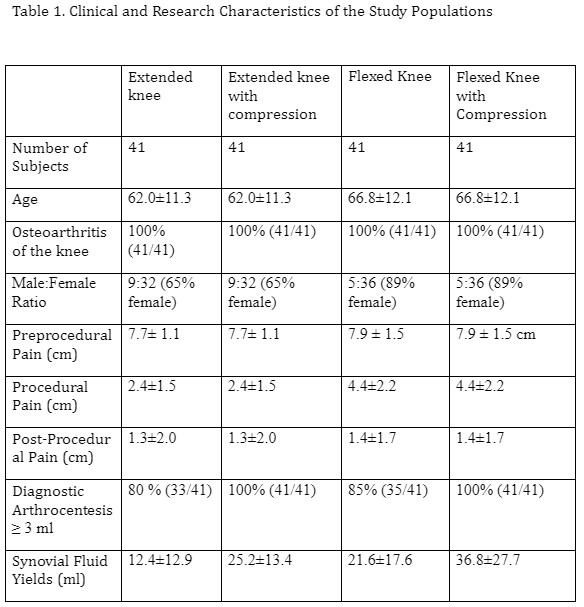Session Information
Session Type: Poster Session B
Session Time: 8:30AM-10:30AM
Background/Purpose: To explore an alternative to standard extended knee arthrocentesis using pneumatic compression of the flexed knee.
Methods: Using a paired sample design, 41 consecutive effusive knees underwent arthrocentesis in the flexed knee position first without and then with pneumatic compression of suprapatellar bursa. Arthrocentesis success and fluid yield in milliliters (ml) were measured. For comparison 41 consecutive patients who had undergone extended knee arthrocentesis without and with compression were also studied.
Results: Successful diagnostic arthrocentesis (≥ 3 ml) of the effusive flexed knee was 85% (35/41) without compression and increased significantly to 100% (41/41) with pneumatic compression (p=0.027). Synovial fluid yields were significantly greater with pneumatic compression (36.8±27.7 ml) than without compression (15.2±17.6 ml) (increase of 142% or 21.6±17.6 ml more; 95% CI: 13.0 < 23.4< 33.8, p< 0.0001). Arthrocentesis yield for the extended knee position without compression (12.4±12.9 ml) was similar to the flexed knee without compression (15.2±17.6 ml; 95% -9.9412 < -3.1< 3.7412 (Wald) p=0.36). Arthrocentesis yield for the extended knee with compression (25.2±13.4 ml) was enhanced by 108% (12.8±13.2 ml) similar to the flexed knee with compression (142%, 21.6±17.6 ml).
Conclusions: Compression of the effusive flexed knee with a suprapatellar pneumatic cuff markedly improves the success and fluid yield of arthrocentesis and is non-inferior to standard extended knee arthrocentesis with or without compression. Arthrocentesis of the flexed knee with pneumatic compression is especially useful in patients who wish to remain seated or who cannot extend their knee due to flexion contracture, wheelchair confinement, pain or severe arthritis.
Conclusion: For individuals with knee contractures, the obese, wheelchair-bound individuals, the elderly, or those apprehensive individuals who involuntarily and forcefully contract the quadriceps muscles during a procedure, the standard extended knee superiolateral approaches for arthrocentesis can be difficult and/or inconvenient. Compression of the effusive flexed knee with a suprapatellar pneumatic cuff markedly improves the success and fluid yield of arthrocentesis and is non-inferior to standard extended knee arthrocentesis with or without compression. This pneumatic compression method that permits the patient to remain in the sitting position or equivalent with a flexed knee, but provides high levels of arthrocentesis success and fluid yield will be of obvious clinical utility.
To cite this abstract in AMA style:
Brahmbhatt S, Iqbal A, Farshami F, Muruganandam M, Trost J, Cisneros D, Kiani A, Emil N, Nunez S, Hayward W, Band P, Sibbitt W. Enhanced Arthrocentesis of the Flexed Knee with Pneumatic Compression [abstract]. Arthritis Rheumatol. 2021; 73 (suppl 9). https://acrabstracts.org/abstract/enhanced-arthrocentesis-of-the-flexed-knee-with-pneumatic-compression/. Accessed .« Back to ACR Convergence 2021
ACR Meeting Abstracts - https://acrabstracts.org/abstract/enhanced-arthrocentesis-of-the-flexed-knee-with-pneumatic-compression/



